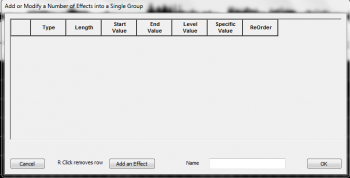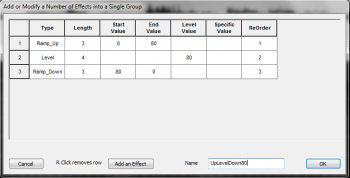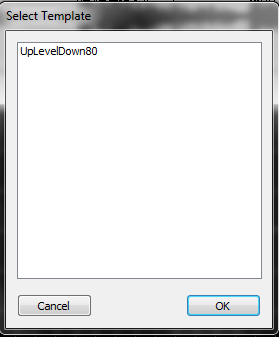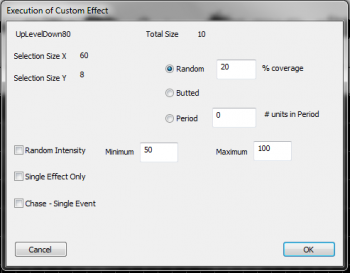Custom Effects: Difference between revisions
No edit summary |
|||
| (One intermediate revision by one other user not shown) | |||
| Line 12: | Line 12: | ||
---- | ---- | ||
[[File:HLS_CustomEffects_Blank.png|thumb|Figure 5-30]] | [[File:HLS_CustomEffects_Blank.png|350px|thumb|Figure 5-30]] | ||
[[File:HLS_CustomEffects_AddEffect.png|thumb|Figure 5-31]] | [[File:HLS_CustomEffects_AddEffect.png|350px|thumb|Figure 5-31]] | ||
When you Add a Custom Effect Group, the Custom Effect window will open (see Figure 5-30). | When you Add a Custom Effect Group, the Custom Effect window will open (see Figure 5-30). | ||
*Click the ''Add an Effect'' button to add a row where you will enter your effect data. | *Click the ''Add an Effect'' button to add a row where you will enter your effect data. | ||
| Line 22: | Line 22: | ||
**''End Value:'' Intensity value at the end of the effect. (active for ramps only) | **''End Value:'' Intensity value at the end of the effect. (active for ramps only) | ||
**''Level Value:'' Intensity value of a level effect. (active for level only) | **''Level Value:'' Intensity value of a level effect. (active for level only) | ||
**''Specific Value:'' | **''Specific Value:'' This sets a specific DMX value (0-255) rather than the normal behavior of percentage (0-100) | ||
**''Reorder:'' Used when reordering the effects that make up the custom effect. | **''Reorder:'' Used when reordering the effects that make up the custom effect. | ||
| Line 30: | Line 30: | ||
*Once you are satisfied with the components that make up your custom effect, type a name in the Name field and click OK (see Figure 5-31). | *Once you are satisfied with the components that make up your custom effect, type a name in the Name field and click OK (see Figure 5-31). | ||
<br clear=all> | <br clear=all> | ||
====Placing a Custom Effect into a Sequence==== | ====Placing a Custom Effect into a Sequence==== | ||
| Line 37: | Line 36: | ||
=====Selecting Cells and the Custom Effect Template===== | =====Selecting Cells and the Custom Effect Template===== | ||
---- | ---- | ||
[[File:HLS_CustomEffects_TemplateSelect.png|thumb|Figure 5-32]] | [[File:HLS_CustomEffects_TemplateSelect.png|350px|thumb|Figure 5-32]] | ||
Now that you have built your custom effect, you can use it in a sequence. | Now that you have built your custom effect, you can use it in a sequence. | ||
| Line 48: | Line 47: | ||
=====Executing the Custom Effect===== | =====Executing the Custom Effect===== | ||
---- | ---- | ||
[[File:HLS_CustomEffects_ExecutionofCustomEffect.png|thumb|Figure 5-33]] | [[File:HLS_CustomEffects_ExecutionofCustomEffect.png|350px|thumb|Figure 5-33]] | ||
The Execution window (see Figure 5-33) is where you tell HLS very specifically how you want the custom effect applied. This is truly where the power and customization of HLS shines through. | The Execution window (see Figure 5-33) is where you tell HLS very specifically how you want the custom effect applied. This is truly where the power and customization of HLS shines through. | ||
Latest revision as of 00:39, 26 October 2013
Introduction to Custom Effects
Custom Effects are a combination of multiple effects that can be applied to a sequence in a variety of ways. This creates a very custom yet clearly defined effect. This is one of the most powerful features of HLS. The first step is to create an effect template from defining an order of basic effects. Then, that template is applied to a selection box in a number of configurable ways to create the custom effect.
To create your first Custom Effect, click Effects -> Add a Custom Effect Group.
Building a Custom Effect Template


When you Add a Custom Effect Group, the Custom Effect window will open (see Figure 5-30).
- Click the Add an Effect button to add a row where you will enter your effect data.
- Column Definitions:
- Type: General type of effect (level, ramp up, ramp down, specific?)
- Length: the length of the effect in grid cells.
- Start Value: Intensity value at the start of the effect. (active for ramps only)
- End Value: Intensity value at the end of the effect. (active for ramps only)
- Level Value: Intensity value of a level effect. (active for level only)
- Specific Value: This sets a specific DMX value (0-255) rather than the normal behavior of percentage (0-100)
- Reorder: Used when reordering the effects that make up the custom effect.
- Continue adding effects until you have completed your custom effect.
- To remove an effect row, right-click on the left-most column (where the number appears).
- To Reorder effects, Change the numbers in the reorder column.
- Once you are satisfied with the components that make up your custom effect, type a name in the Name field and click OK (see Figure 5-31).
Placing a Custom Effect into a Sequence
Selecting Cells and the Custom Effect Template

Now that you have built your custom effect, you can use it in a sequence.
- Select the grid cells and channels on which you wish to place the custom effect.
- Press the Custom button or C and a window will open for you to select the custom effect (see Figure 5-32).
- Select your effect and click OK. This will open the Execution of Effect window.
Executing the Custom Effect

The Execution window (see Figure 5-33) is where you tell HLS very specifically how you want the custom effect applied. This is truly where the power and customization of HLS shines through.
The layout of the window contains basic information in the top left:
- The name of your custom effect template and it's size.
- Selection Size X/Y: This is the number of grid cells selected (X), and the number of channels (Y) that you will apply the effect to.
Modifying the pattern of how the effect is applied:
- Random Coverage: This will place the custom effect randomly throughout the selection box. The %Coverage lets HLS know what percentage of the cells contained in the selection box should be covered by the effect.
- Butted: This means the effects will be placed right next to each other. HLS will place your custom effect back-to-back in each selected channel all the way to the end of your selection.
- Period: This will apply your custom effect every defined period of cells. This period is the "wait time" before the next custom effect is applied. For example, a period of 4 would apply your custom effect, leave 4 grid cells blank, then reapply the effect, and so on.
Additional Modifiers:
- Random Intensity: This will apply your custom effect using a random intensity, from your custom low value to high value.
- Single Effect Only: This will apply your custom effect one time only, exactly as you defined it.
- Chase - Single Event: This will draw your custom effect one time, and chase it through the channels contained in your selection box.
RGB Channels and Custom Effects
- If you wish your custom effect to be a color other than white, use the color-specified custom button on the toolbar.
- Select the rectangle and choose the color you wish to use for the rgb channels. Click the color-coded custom button.
- Configure your Custom effect as described in the sections above.
- It will apply the custom effect in the color chosen.
| HLS User Manual and Reference Guide | ||
|---|---|---|
| Previous Page | Current Chapter | Next Page |
| Sequencing with RGB Effects | Chapter 5: Sequencing Channels and Adding Effects | Creating a Library of Group Effects |